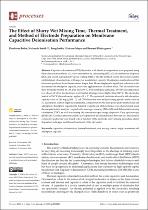| dc.contributor.author | Botha, Ebrahiem | |
| dc.contributor.author | Smith, Nafeesah | |
| dc.contributor.author | Hlabano-Moyo, Bongibethu | |
| dc.date.accessioned | 2022-05-23T09:02:14Z | |
| dc.date.available | 2022-05-23T09:02:14Z | |
| dc.date.issued | 2021 | |
| dc.identifier.citation | Botha, E. et al. (2021). The effect of slurry wet mixing time, thermal treatment, and method of electrode preparation on membrane capacitive deionisation performance. Processes, 9(1). http://dx.doi.org/10.3390/ pr9010001 | en_US |
| dc.identifier.issn | 2227-9717 | |
| dc.identifier.uri | http://dx.doi.org/10.3390/ pr9010001 | |
| dc.identifier.uri | http://hdl.handle.net/10566/7441 | |
| dc.description.abstract | Capacitive deionisation (CDI) electrodes with identical composition were prepared using
three deposition methods: (1) slurry infiltration by calendering (SIC), (2) ink infiltration dropwise
(IID), and (3) ink deposition by spray coating (IDSC). The SIC method clearly showed favourable
establishment of an electrode with superior desalination capacity. Desalination results showed that
electrodes produced from slurries mixed longer than 30 min displayed a significant reduction in the
maximum salt adsorption capacity, due to the agglomeration of carbon black. The electrodes were
then thermally treated at 130, 250, and 350 ◦C. Polyvinylidene difluoride (PVDF) decomposition
was observed when the electrodes were treated at temperatures higher than 180 ◦C. The electrodes
treated at 350 ◦C showed contact angles of θ = 0◦
. The optimised electrodes showed a salt adsorption
capacity value of 24.8 mg/g (130 ◦C). All CDI electrodes were analysed using specific surface area by
N2 adsorption, contact angle measurements, conductivity by the four-point probe method and salt
adsorption/desorption experiments. Selected reagents and CDI electrodes were characterised using
thermogravimetric analysis coupled with mass spectrometry (TGA-MS) and differential scanning
calorimetry (DSC), as well as scanning electron microscopy energy dispersive X-ray spectroscopy
(SEM-EDS). | en_US |
| dc.language.iso | en | en_US |
| dc.publisher | MDPI | en_US |
| dc.subject | Capacitive deionisation | en_US |
| dc.subject | Thermal treatment | en_US |
| dc.subject | Wet mixing | en_US |
| dc.subject | Maximum salt adsorption capacity | en_US |
| dc.subject | Contact angle | en_US |
| dc.title | The effect of slurry wet mixing time, thermal treatment, and method of electrode preparation on membrane capacitive deionisation performance | en_US |
| dc.type | Article | en_US |

